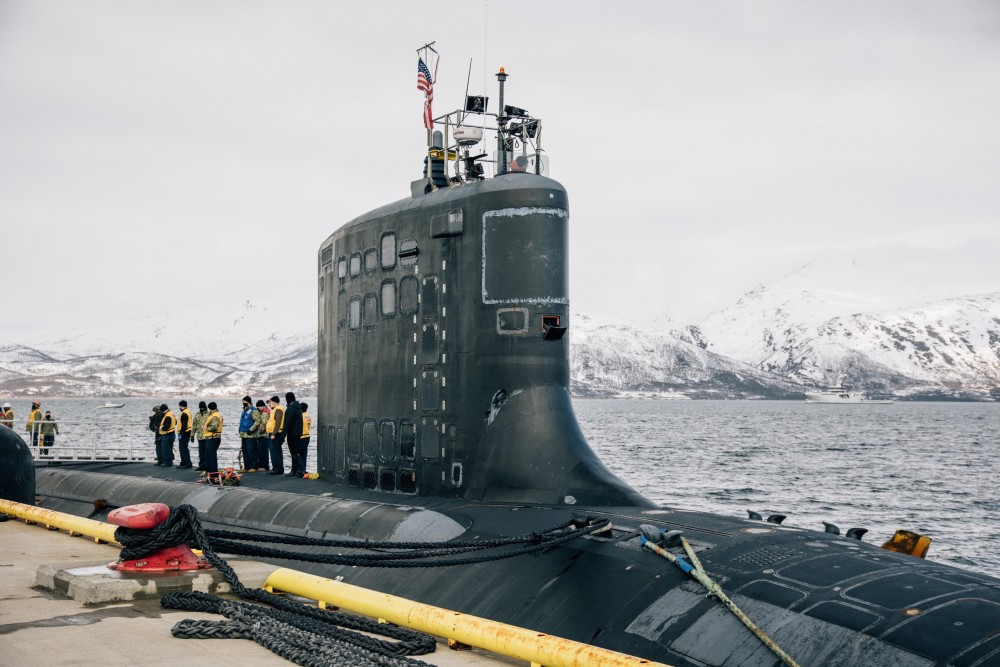USS New Mexico docked in Tromso on Monday as Norway, US bolster Arctic military ties

The nuclear-powered Virginia class fast-attack submarine is the first to make port call to the civilian harbor just north of Tromsø in northern Norway.
“We have been working hard with the preparedness and monitoring ahead of this port call,” said Inger Margrethe Eikelmann, head of the regional department of Norway’s Radiation and Nuclear Safety Authority (DSA).
The radiation watchdog is now intensifying measurements of radioactivity in the air and near the harbor.
“There are obviously several challenges for our monitoring- and emergency preparedness work as the submarine stays in port for several days so close to the city, compared with a short stop out in open waters,” Eikelmann said to the Barents Observer.
The DSA is supported by CBRN troopers from the Norwegian Armed Forces, specialists on chemical, biological, radioactive and nuclear tasks.
US nuclear-powered submarines have over the last few years increased sailings in the north. Crew change and supply arrangements have until now been arranged in the fjords outside Troms in northern Norway.
On Monday, however, the first docking took place, as the “USS New Mexico” came to Tønsnes municipal harbor some 10 kilometers north of Tromsø city center.
Security is tight. A no-fly zone is established over the port, and access to the harbor area is strictly guarded by the Norwegian Armed Forces. The military guarding of the port will only last for as long as the submarine stays. Normally, the port in Tønsnes serves civilian vessels in Tromsø, including the oil and gas supply activities offshore northern Norway.
The USS New Mexico is one of 19 vessels in the Virginia class, the United States latest generation of cruise missile-carrying fast attack submarines.
The submarine is 113 meters long and has a crew of 130.
Security cooperation
Spokesperson with the U.S. 6th Fleet, LCDR Matthew Comer, said to the Barents Observer that the submarine is on a scheduled visit to Tromsø.
“This visit serves to deepen security cooperation with Norway, as we work together for a stable secure and prosperous maritime domain,” Comer said. He points to the fact that the Untied States and Norway are close NATO allies and collaborate on a wide range of issues important to both nations and to the rest of the Alliance.
“A free and open maritime domain is critical to the economic security and prosperity of the global economy. The U.S. and Norway have a vested interest in ensuring open sea lanes in the region,” Matthew Comer said.
A few protesters
Arriving at the port around noon on Monday, the American submarine was met by a few protesters from the local organization “No to Nuclear-powered Military vessels in Tromsø” holding banners “U.S. Army out of Norway” and “No nukes in Tromsø”.
Also, Moscow has said it is unhappy with Norway allowing for American submarines to make port calls.
However, Norway gives green light for the use of Tønsnes harbor facility just north of Tromsø for allied submarines with reactor propulsion. The new security situation in Europe, including in the north, requires closer naval cooperation between NATO members.
Keeping track of the Russian Northern Fleet’s submarines sailing out from the Kola Peninsula to the North Atlantic is a priority.
Last Friday, Russia’s by far most advanced nuclear-powered multi-purpose submarine, the “Kazan”, was finally handed over to the navy from the Sevmash shipyard who had spent nearly 12 years to built the vessel. Seven similar subs are currently under construction in Severodvinsk.
The new Northern Fleet submarines sail more silent than the older Soviet-designed vessels. And they sail more frequently out from the Barents Sea to the west of North Cape, into the deeper Norwegian Sea. That worries NATO.
Typically, an American submarine on a mission in the Norwegian Sea would not want to sail all way south to Haakonsvern near Bergen or to a naval base in the United Kingdom to put on shore a crew member or pick up some new devices or supply. Surfacing near the area where the cat-and-mouse hunt with the Russians takes place saves time.
Norway’s Defense Minister, Frank Bakke-Jensen, argues that it is better and safer for a submarine to make a port call than to change crew in open waters.
In recent years, NATO submarines have been inshore Norwegian waters 3 to 4 times per month for crew change or getting supplies. The majority is up north, as previously reported by the Barents Observer.
Last August, the “USS Seawolf” conducted a brief stop in the fjord near Tromsø for personnel change before sailing out to waters inside the Arctic Circle.
Like it was during the Cold War, NATO submarines making port calls to northern Norway is the new normal.
Related stories from around the North:
Canada: Canada’s military launches scaled down annual Arctic exercise, Radio Canada International
Finland: Finnish Defence Minister tells party leaders shrinking fighter fleet would be “irresponsible”, Yle News
Iceland: Iceland talks Arctic, Trump’s ditching of climate accord, with U.S. Secretary of State, Eye on the Arctic
Norway: Norway strengthens its Arctic military in new defense plan as security concerns grow in the region, The Independent Barents Observer
Russia: Russia’s FM spokesperson calls Norway’s military deal with U.S. “provocative”, The Independent Barents Observer
Sweden: Arctic Sweden to welcome thousands of international troops for Northern Wind exercise, The Independent Barents Observer
United States: U.S. Navy to build airport infrastructure in North Norway to meet upped Russian submarine presence, The Independent Barents Observer



